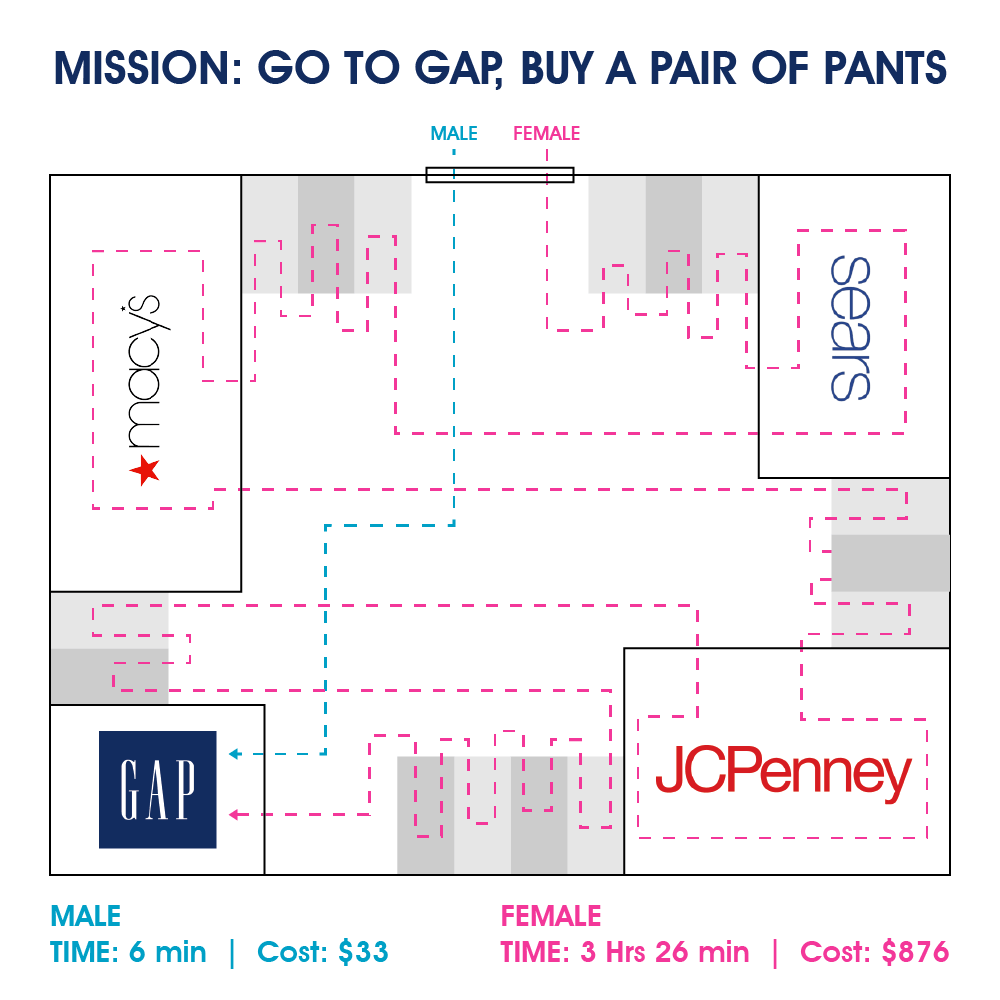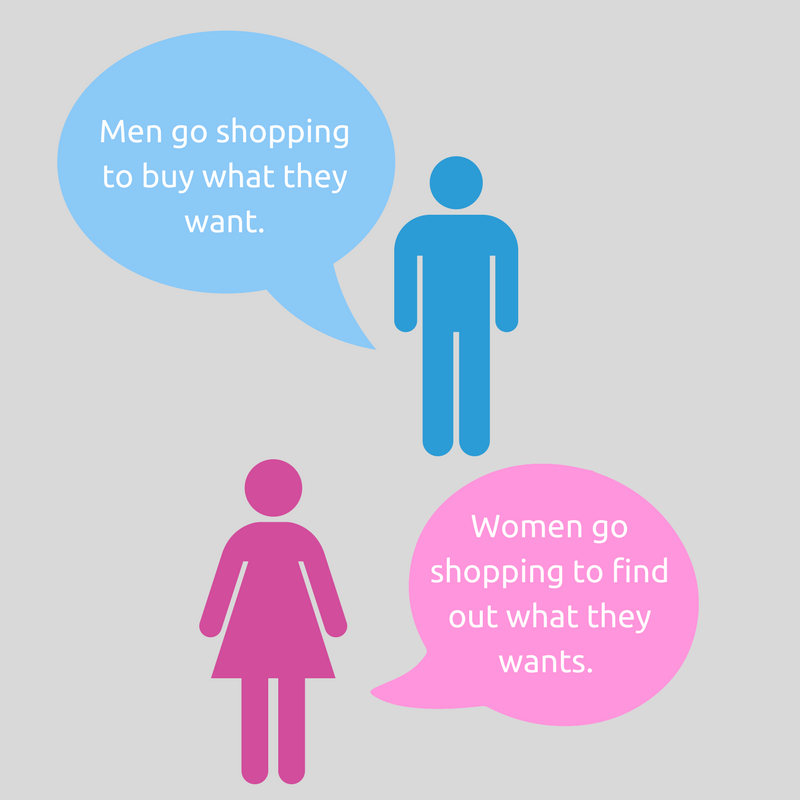Men Buy Women Shop – Gender-based Consumer Behavior Insights for Marketers!
Consumer behavior interpretation is not a nascent discipline but the gender difference in attitude towards purchase is fairly recent. After the women empowerment movement caught speed, more females are now in charge of the purchase decisions not only for themselves but for the whole household. They will not be shy to spend if they get excellent service and are taken care of at each stage, from product selection to purchase and after sales support. They dig for answers and if any brand leaves its customers with too many queries then their business will be in deep trouble.
Men on the other hand are more logic oriented, they will not like a salesperson hovering besides them telling them what to buy. Shopping is a mission for them and they don’t like to spend too much time on it which is why they are more brand loyals. Men are fascinated by the utilitarian aspects of a product including its features, certifications and warranties. Hence marketing to genders is becoming a complicated science. However, this image will simplify how the two genders approach the same need.

It won’t be wrong to say that men shop smartly to save time whereas women spend time on shopping because they are thinking of the long term. They can easily be attracted by fresh brands who know how to connect on a personal level.
The difference basically lies in the way both genders think about shopping. For men, it is more of a mission. They will go towards the aisle where they know their product is, buy it and leave the store. As for women, shopping is more like a journey. Most often they tend to measure the value of the buck by the kind of service. So once again the energy for purchase decision is driven by emotions which is why females tend to have a hedonic motive for shopping.
Shopping Motives – The Gender Differences
Even when both genders may have the same need, the motive tends to differ. The two different motives that govern shopping decisions in the two genders are utilitarian and hedonic.
Utilitarian
Utilitarian motive involves the conscious pursuit of intended products, more like a purpose driven shopping. Usually men want to save time and so they focus on getting the thing done. Men go for the utilitarian approach by taking logic into account. While pitching to a male, a salesperson should ideally focus on the product features. Focus more on value prospects without wasting time. After all, men will make the purchase decision based on logic.
Hedonic
Hedonic motive involves a more personal touch and relate to intrinsic abilities. Now this brings shopping for experience into the picture. Usually females have this emotional attachment to shopping. They love shopping! So to engage a female, a more emotional connection has to be created. A vast majority of women are impulse buyers and they are interested to know more about an interesting brand. If you are able to create an emotional experience, then you have caught their interest.

What marketers should do?
Create an impactful marketing and attractive visual cues and select a visible position for ad placement for females.
Focus on the benefits more than on product features for males.
Differences in the Brain
Multiple studies have been conducted to find out the reasons for apparent disparities. As it turns out, it’s all in the brain. The left hemisphere of the brain is responsible for logical processing whereas the right hemisphere analyzes visual imagery and interprets context. Explore the reasons for differences.
Reasons for Differences
Men tend to use the left hemisphere for decisions whereas women use both sides which explains why they are always inconclusive and confused. They search for details and interpret the visual aspects of the brand. Sometimes emotional branding strikes a chord and they are tempted to hit a purchase
Jokes apart, men tend to be task-oriented shoppers while women are more discovery-oriented ones.
What marketers should do?
For men create obvious visual cues and clearly provide all product related details.
For women, add a story or an emotional effect.
Females Dig Deeper, Males Want Effortless Shopping
We have seen how the brains of the two genders are wired differently. This has been proven through consumer studies on shopping orientation and gender differences that women will research through websites, create comparisons and read reviews to form an opinion whereas the male counterparts will make quick decisions and they will be happy with it. So what are consumer practices and how can marketers use this to their advantage.
Consumer Practices
Once again, women enjoy browsing through different products they may not need. To attract and retain them, retailers should have a user friendly interface that supports interactive visuals and customer reviews.
 Image Source: Freepik
Image Source: Freepik
Men will not have a profound research in advance but they will be inclined to buy a product that they know as a result of word-of-mouth marketing.
What marketers should do?
Create presence on social media platforms where users can interact and share reviews.
Interpersonal vs. Instrumental Approach
“When it comes to the retail experience, men and women both go into the store to buy something, only she wants more. She wants more interaction. She wants more eye contact. He wants quick answers while she’s looking for support and collaboration in the buying process.”
What does that imply about a female shopper? They invest their energies to feel connected to the shopping experience. However it must be noted that it’s a generic behavior. If she is short of time, she might behave like the male respondents who just buy what they came for and leave. The two approaches used here are instrumental and personal.
Male are instrumental shoppers
Men see shopping as a means to get things done. They might seem too much concerned about the price but they tend to be hardcore brand loyal. No matter how attractive your campaign is, it is hard to convince a male shopper to actually leave their favorite brand and choose yours. Usually, they will go with something that has already been tested.
Females are personal shoppers
Females would like a more inter-personal experience where they get a feeling that a brand takes care of them. Now in this case, an emotive experience will not be the only deal sealer, you need to have an exceptional after sales service to answer all their queries about the product usage. That’s how brands can create female brand loyals.
What marketers should do?
Create a story, highlight the emotional benefits and a strategy that enables the user to create an association.
Quick Assistance vs. Updation
Despite listing all details and product specifications, there is category that will need a sales person to answer more question. Most often this customer turns out to be a female. As for the males, its not like they don’t have questions regarding a product but they have a different approach to getting answers. They would not like a salesperson asking for assistance. Rather they want the provide cues about the product features. Business tend to see consumers as unisex while preparing strategies. They should study and comprehend the gender approach to shopping.
Shoppers Who Like Quick Assistance
The shopping experience for women largely relies on help and guidance from sales persons. The lack of help when needed has emerged as one of the top problems they encounter in shopping experience, which makes it the prime reason why some businesses tend to lose their female shoppers.
Shoppers Who Like Updates
According to men, the difficulty in finding a parking space is the number one problem. Also if they find the item they came to buy is out of stock, they would not like to return to that store. A retailer that has not updated according to the requirements and shopping preferences of both genders will lose customers faster than it can gain.
What marketers should do?
When a new brand is launched, make sure the information and features are standardized across the board whether it’s the physical world or the digital world.
Fast Check out vs. Feeling Important
When interviewed by a team of researchers, women describe the best store as the one where they feel that the sales staff is compliant and guides them throughout their shopping journey. Men would rate a store for its speedy service.
The experts have some suggestions
Paula Courtney, president of the Verde Group, suggests:
“The attitudes expressed toward sales associates reflect subtle, but important, differences between men and women. What problem would make respondents so angry they would never return to a store, women cited employees who “acted like you were intruding on their time or their own conversations.” Men were most miffed by employees who were “lazy, i.e., would not check for additional stock or take you to the item you were looking for.”
What marketers should do?
Create comparisons and personalize the product or service. This can be an attempt to cover up the cons of the system that are beyond the control of a marketer.
Females Are Less Certain About Online Shopping Than Males
Online shopping sales have escalated in the past 5 years however, females perceive a higher level of risk in online shopping as compared to males. Male consumers are more focus driven and think about the value gain form the purchase. So what’s the risk in online shopping?
Online Shopping Risks
Generally both male and female shoppers usually don’t perceive sharing information as any kind of risk. However, females have trust issues and are sensitive to risk. Unless it is a tested brand, they prefer not to share private information. Hence while designing a strategy, it is important to keep in mind the female prospects who still see risk in online shopping.
What marketers should do?
Create ad campaigns that enable women to create an association with women empowerment and use of digital technology.
Purchasing Through Mobile Devices
For a brief period, women were behind men in terms of adopting to new technology. However now they have caught up and we can account this as a success for the marketing efforts of fashion brands. Let’s dig into some stats.
Online Mobile Shopping Trends
According to a 2013 study conducted by See Why, 57% of women purchased goods online, compared to 52% of men. The constant shift in the stats of mobile users indicate that irrespective of the gender, millennial depict interesting buying behavior on mobile. Hence both genders are promising candidates for purchasing through mobile.
Together 82% of the customers (smartphone users) turn to their devices to help them make a product decision. 66% of smartphone users turn to their phones to look up something they saw in a TV commercial of which majority are females.
What marketers should do?
Retain more females on mobile by giving them the experience online and attract more males by providing solid comparisons through reviews.
Conclusion
Every shopper is unique and has a unique set of needs that businesses should be aware of. Why? Because this is the age of personalization. It is more important to focus on who you are selling to than what you are selling. Knowing the consumer behavior of both genders towards shopping will enable marketers to create strategies to improve customer engagement, conversion and loyalty. Check out the infographic summarizing the gender disparity when it comes to shopping decision.



